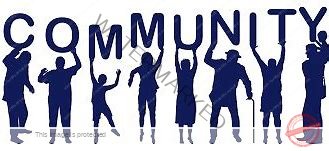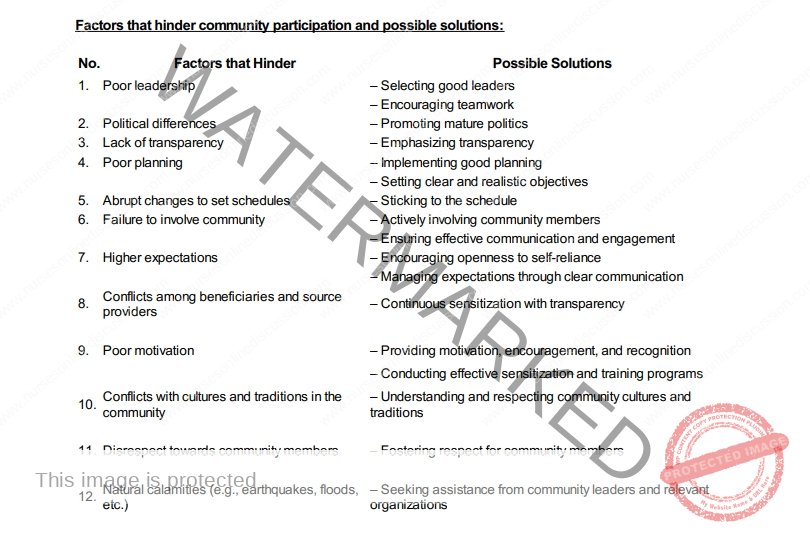Principles of Primary Health care
Subtopic:
Community Participation

Community participation happens when community members gain the power to be involved in identifying problems, prioritizing them, finding possible solutions, making decisions, putting them into action, and checking and assessing what is happening for their own health and progress.
- Community participation happens when community members gain the power to be involved in identifying problems, prioritizing them, finding possible solutions, making decisions, putting them into action, and checking and assessing what is happening for their own health and progress.
- Community participation is a process where a community actively identifies its problems, decides on what actions to take, and implements those actions. It’s more than just using services; it means being active participants, not just passive recipients. This naturally follows Community Mobilization
Principles of Community Participation
Grassroots approach: Community participation starts at the local level, involving communities in making decisions about things that directly affect their lives. It acknowledges that communities possess valuable insights and perspectives that should be considered when developing interventions and programs.
Democratic method: Community participation makes sure everyone in the community has a chance to be involved and give their input. It encourages inclusion, openness, and equal opportunity to participate, allowing community members to express their views, contribute to discussions, and ensure their voices are heard.
Supportive setting: Community participation establishes a positive environment that helps communities grow and develop. It empowers community members to take ownership of programs and initiatives, creating a sense of responsibility, dedication, and accountability.
Shifting power: Community participation changes the usual power dynamic from external experts to the communities themselves. It values the knowledge and real-life experiences of community members and includes them in all steps, including:
Assessing needs, like identifying health concerns or lack of resources.
Setting priorities, such as deciding which problem needs to be addressed first.
Planning interventions, like designing a health awareness campaign.
Putting plans into action, like organizing community clean-up drives.
Checking and assessing programs, like evaluating the success of a new water system.
Types of participation
Token participation: Participation is just for show. Individuals are placed on official boards or committees but lack real power to make decisions. Their presence is used to give the appearance of community involvement.
Informed participation: Community members are told about decisions or actions already made by outside groups. They are not actively part of the decision-making process and simply receive information or give feedback afterward.
Consultative participation: Community members are asked for their opinions or feedback, often by external organizations. However, the power to make decisions remains with professionals or experts, and community input might not significantly influence the final plans.
Incentivized participation: People participate because they receive something in return, like food, money, or other benefits. Their involvement is mainly driven by these tangible rewards for their time, effort, or resources.
Task-oriented participation: Community members are involved in specific, pre-defined tasks related to a project. Their involvement happens after the main decisions are made, and their role is to carry out specific objectives rather than being involved in the decision-making itself.
Collaborative participation: Community members and external groups work together to solve problems and plan actions. It encourages active involvement and gives local groups control over local decisions. This type of participation recognizes the value of community input and ensures people have a say in decisions that affect them.
Self-initiated action: Community members take action on their own to address and change systems or situations without depending on outside organizations. It’s a self-led form of participation where communities take responsibility for their own development and work towards achieving their goals.
Indicators for community participation
Community groups: This looks at the existence and operation of community groups or clubs, such as youth groups, women’s groups, or other local organizations. It shows how well the community works together.
Women’s involvement: This checks the involvement of women in making decisions at home and in the community. It shows the empowerment of women and the recognition of their voices and contributions in community matters.
Community contributions: This measures how much the community is involved in development activities and projects. This includes providing labor, materials, and financial contributions. It shows the level of ownership and commitment of community members.
Keeping records: Keeping records of community activities, like meeting notes, progress reports, or project documentation, indicates community participation. It shows the community’s involvement in planning, implementing, and monitoring initiatives.
Using local resources: This assesses how often community members use local resources and services for their own development. It shows the community’s ability to rely on itself and meet its needs using local means, for instance, utilizing local healers or traditional knowledge.
Response to mobilization: This measures how well community members respond and engage when asked to participate in community activities or projects. It shows the level of interest, commitment, and active involvement within the community.
Shared leadership: This focuses on how leadership roles and responsibilities are distributed among community members. It reflects a fair and inclusive way of making decisions and developing the community.
Seeking external help: This assesses the community’s efforts to find outside support, both technical and material, to add to their own resources and abilities. It demonstrates the community’s ability to network and find resources.
Importance of Community Participation
Right to decide: Community participation ensures people have the right to be involved in making decisions that directly affect their lives. It supports democratic principles and gives community members a voice in shaping their own future.
Increased service use: When community members actively participate in planning and implementing projects or services, they are more likely to use and benefit from them. Their involvement creates a sense of ownership, making them more invested in using the resources available to them, like attending health clinics or using new sanitation facilities.
Sense of ownership: By actively participating in community initiatives, people develop a sense of responsibility and ownership. They take pride in what they have helped create and are more likely to care for and maintain the activities or programs.
Long-term success: Community participation helps initiatives last longer. When community members feel ownership, they are more dedicated to maintaining and improving projects, ensuring their ongoing success even after external support decreases.
More resources: Community participation brings in extra resources like labor, materials, money, and volunteer time. With more resources available, planned activities can be carried out more effectively, leading to better results, such as a community building a school using local materials and volunteer labor.
Better planning and implementation: When community members participate in planning and implementation, they have a better understanding of the goals and reasons behind the activities. This shared understanding leads to more efficient planning and smoother implementation of projects.
Building confidence and unity: Active community participation builds confidence among individuals as they see the positive results of their contributions. It also builds a stronger sense of unity and togetherness within the community as members work together towards shared goals.
Empowerment and skill development: Participation empowers community members by giving them a sense of agency and control over their own development. Through participation, individuals gain valuable skills, knowledge, and experience, contributing to their personal growth and the overall ability of the community, such as learning new farming techniques or gaining leadership skills.
Ways in which community members participate in development activities / projects
Using the services provided, such as attending health clinics or enrolling children in new schools.
Providing resources (labor, materials, money, and time) for planned activities, like helping to build a community center or donating supplies.
Monitoring and evaluating programs of planned activities, such as checking the progress of a construction project or providing feedback on a training program.
Participating in making decisions about plans, like choosing the location for a new well or selecting priority health interventions.
Factors that promote community participation
Good leadership: Effective leadership builds trust and confidence among community members, ensuring their resources will be used honestly and for their benefit. Trust in leaders encourages active involvement.
Good planning: When community members are involved in the planning process, they feel ownership and are more likely to participate actively in the activities. Their input in identifying needs, setting goals, and deciding how to implement strategies increases their commitment.
Clear project understanding: Community members should clearly understand the project’s goals, expected results, and the roles and responsibilities of everyone involved. This clarity helps individuals see the value of their participation and how their contributions help the project succeed.
Effective communication: Open and consistent communication about the project’s purpose, challenges, benefits, and what is expected from participants is crucial. When people have a full understanding of the project, they are more motivated to get involved.
Knowledge and skills: Community members need the necessary knowledge, positive attitudes, and skills to actively participate in project activities. Providing training and opportunities to build skills ensures individuals feel capable and confident in their roles.
Positive attitudes: A positive and supportive attitude towards working with others encourages collaboration and cooperation. Creating an environment where community members, leaders, and project staff have a positive attitude towards working together encourages greater participation.
Cooperation: Building strong relationships and fostering cooperation between project staff and the community is essential. Collaboration ensures everyone is working towards a common goal and that decisions are made together.
Involving different groups: Engaging and involving various sectors within the community ensures different viewpoints are considered, increasing the diversity and effectiveness of community participation.
Income opportunities: Encouraging the community to engage in income-generating activities fosters economic empowerment and motivates individuals to actively participate in community initiatives. Economic opportunities can improve the overall well-being of community members and strengthen their commitment to the project.
Levels of Community Participation
Participation in service use: This level involves actively encouraging the community to use available services, like public health campaigns or educational programs. Community members are encouraged to take advantage of the services provided.
Participation in existing programs: At this level, the program content is developed outside the community, and community committees or representatives are invited to help put the plan into action. For example, communities might be involved in tree planting or maintaining local roads.
Community involvement in decisions: This level of participation involves helping community committees or groups develop essential skills for analyzing situations, identifying problems, setting priorities, and planning actions. The community is actively involved in assessing local needs, making decisions, and implementing appropriate plans, such as developing a local health plan.
Community empowerment: At this highest level of participation, the community becomes knowledgeable and empowered enough to take full control of the development process. Community members are actively involved in all aspects of deciding, planning, implementing, and evaluating programs and initiatives. Achieving community empowerment requires proper preparation and capacity building of the facilitators or personnel supporting the community’s development journey.
Note: Moving from one level to another can take time and requires careful preparation and support to ensure the community is meaningfully and effectively involved throughout the process.

Effective community participation leads to:
Greater ownership by the community.
Increased self-reliance among community members.
Development of skills and abilities to support the primary healthcare (PHC) process.
More efficient and effective implementation of PHC.
Fairer distribution of resources within the community.
Get in Touch
(+256) 790 036 252
(+256) 748 324 644
Info@nursesonlinediscussion.com
Kampala ,Uganda
© 2025 Nurses online discussion. All Rights Reserved Design & Developed by Opensigma.co

